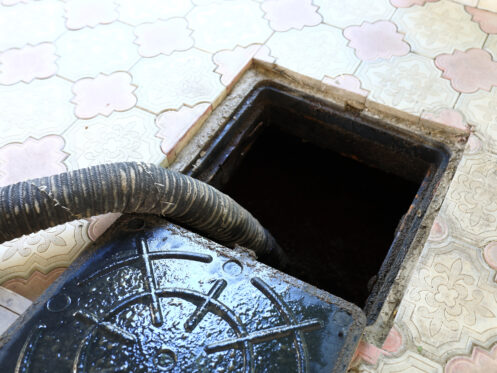The conditions of any sewer system are, in most cases, hazardous for any human worker. Deep underground in the maze of old pipelines, dangerous gases can accumulate, and unstable infrastructure abounds. However, maintaining sewer infrastructure is an essential task for public health and environmental protection. This is where robotics is revolutionizing sewer repair and maintenance work.
Robotic technologies are taking an essential role in replacing human manual work involved in assessing the conditions of sewer infrastructure. Here are the top 10 ways robotics can be used in modern sewer repair services.
1. Repair
When repairs are necessary for cracks, collapsed sections, or other structural failures, robotics plays a vital, hands-on role. Remotely operated robotic cutters can precisely slice through concrete and cast iron and remove sections in need of replacement. Hope Plumbing utilizes robotic welding and installation devices to rebuild pipe integrity through techniques like slip-lining inserts. Robotic crack injection equipment under high-pressure injection repairs minute cracks to avoid further deterioration. All of these robotic repair tools mean human workers don’t have to enter risky confined spaces for hands-on repair work.
2. Mapping
Detailed mapping of sewer systems is another key use of robotic technology. Laser and sonar equipment on robotic units helps produce accurate digital maps of underground pipe networks. Pipe diameter, elevation changes, bends, intersections, and the location of manholes and lateral connections are all recorded during mapping operations. Geographical information systems (GIS) software integrates mapping data to create virtual models of sewer systems. This mapping offers companies a full picture of their infrastructure for planning purposes. It also helps crews locate problem areas more efficiently during maintenance and repairs.
3. Cleaning
After pinpointing problem zones through inspection and mapping, robotics plays an important role in sewer line cleaning and unblocking operations. Robotic cleaning nozzles, buckets, cutters, and root saws are deployed to clear debris, grease, tree roots, and other obstructions from pipelines. Hope Plumbing uses laser-guided robotic cleaning units to ensure thorough removal of buildups throughout pipe networks. This cleaning prevents blockages from occurring and reduces sewage overflows that harm public health and the environment.
4. Maintenance
Keeping sewer infrastructure in good working condition is essential in the long term, with robotics aiding numerous maintenance tasks. Robotic drainage with high-pressure water jets keeps pipes scoured and flowing freely. Robotic CCTV units re-inspect pipes on a schedule to catch problems early. Remotely operated robotic cutting, grinding, and burrowing machines install slip lining and cure-in-place pipe lining to replace degraded pipes. This task can be easily performed without excavation. Maintenance extends sewer system life spans while avoiding disruptions to communities from open-cut replacement projects.
5. Inspection
Advanced inspection robots can map multiple pipelines simultaneously with high-definition cameras and generate 3D renderings of sewer networks. This inspection data aids in planning maintenance and repairs.
6. Monitoring
Continuous monitoring of sewer infrastructure conditions is possible through permanently installed robotic sensors. Smart manhole covers with sensors track rainfall amounts, flows, levels, pressure differentials, gas concentrations, and other parameters to monitor system performance. Permanently installed inline robotic sensors track similar variables throughout pipeline networks. This real-time monitoring data conveyed remotely to control centers helps identify issues early on, like storms causing surcharge or changes indicating structural failures, before overflows occur. It also supports predictive maintenance modeling so that equipment and resources can be deployed efficiently.
7. Data Collection
Data collection serves as another essential robotic role in modern sewer system management. Robotic inspection units equipped with multiple sensors generate enormous troves of condition assessment data regarding infrastructure materials, defects, and degradation factors. GIS mapping data yields asset data on pipe attributes, connections, and system topography. Also, water quality monitoring robots sample wastewater at different points to aid compliance with discharge permits. All this data from robots supports utilities with performance benchmarking, decision analysis, infrastructure investment planning, and sustainability reporting goals relating to aging networks. Advanced analytics applied to these robot-generated data sets enhance the overall management of sewer utilities.
8. Remote Operation
As mentioned, sewer environments pose numerous potential hazards to human workers, such as flammable gases, low oxygen levels, collapse dangers, and infectious diseases. This is where the capability of remotely operating robotic technologies from safe control centers proves invaluable. Sewer robots can be deployed and complete inspection, maintenance, or construction tasks from a distance without endangering staff. Their interchangeable tooling allows taking on different jobs as needed. The remote operation also prevents unnecessary exposure of crews to difficult working conditions, like scrambling through confined spaces deep underground. Workers instead focus on supervising multiple robot teams simultaneously from above-ground control rooms.
9. Hazardous Environment Exploration
Hazardous environment exploration represents another important robotic function. Specifically, equipped exploration robots map out unknown pipelines in collapse or blockage emergency response scenarios. If robots are equipped with gas monitors and other sensors, they can help locate people in distress or map unstable infrastructure that is too risky for human crews. Explosive atmosphere-resistant robots even navigate actively gassy sewer environments to pinpoint sources. All of this hazardous mapping performed by robots keeps responders out of direct danger while still gathering critical infrastructure condition data in crisis events.
10. Infrastructure Assessment
Lastly, assessing the conditions of infrastructure across entire sewer systems relies heavily on robotic technologies. Inspection, structural assessment, and material-testing robots generate the data inputs for advanced modeling programs that determine overall network integrity. They can then predict the remaining life span of these structures. Laser scanning and ground-penetrating radar robots precisely assess asset attributes at scale for large-scale facility planning purposes. This data drives strategic capital planning to rehabilitate or replace aging assets before failures based on projected deterioration rates. By taking the risks out of hands-on assessment tasks, robotics remove safety constraints and allow comprehensive system-wide evaluation for strategic asset management goals.
Robotics has transformed many dangerous, undesirable activities related to sewer system upkeep into remote-controlled precision operations from a safe distance. The high-definition imaging, dexterous manipulation, sensing capabilities, and programmable intelligence of today’s sewer robots automate essential inspection, mapping, cleaning, maintenance, repair, monitoring, data collection, and evaluation functions.
This protects utility worker health and safety while improving the thoroughness and efficiency of these maintenance processes. Most importantly, robotic capabilities continuously improve aging wastewater infrastructure to uphold public well-being and environmental protection for modern communities. Going forward, further robotics and automation advancements will continue to revolutionize underground utility system management practices.
Our Professional Services
While robotics are transforming the behind-the-scenes work of sewer repair and maintenance, our Hope Plumbing can accurately interpret the extensive inspection data, execute repair recommendations, and provide other related services for homeowners and businesses. Beyond sewer scope and hydrojet services, our team at Hope Plumbing offers a full range of plumbing services, including drain cleaning, water heater installation, sump pumps, and more. After more than 15 years of serving Indianapolis and the surrounding areas, homeowners know they can trust us to determine the best solutions for any plumbing or sewer problem using the latest technology and traditional hands-on skills.
Contact us at Hope Plumbing today to learn more or schedule a service in Indianapolis.

